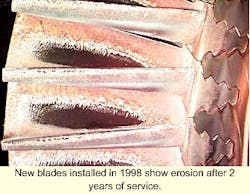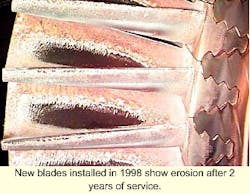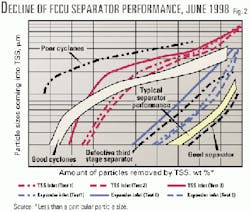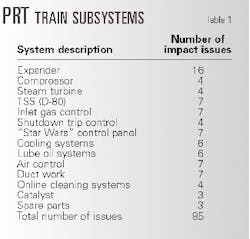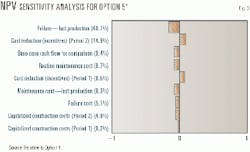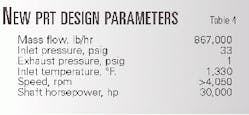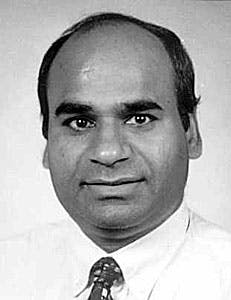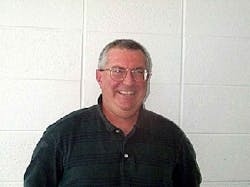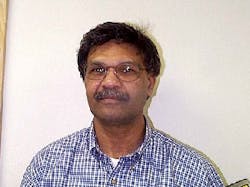BP Amoco's Whiting, Ind., refinery saved millions of dollars by avoiding the purchase of a new power-recovery turbine expander (PRT) to replace its existing one, which experienced four unplanned outages between 1995 and 1998.
A vigorous technical and economic assessment showed that a new PRT would not have solved the machine's reliability problems. Instead, development of appropriate key performance and maintenance indicators kept the existing PRT in operation.
The four unplanned PRT outages, caused by blade and steam-baffle bolting failures, were expensive. The cost of mechanical repair and lost opportunity was tens of millions of dollars along with tremendous strain on the organization, to which no cost can be attributed.
In 1998, BP, then called Amoco, initiated a PRT reliability upgrade project to improve the reliability of its PRT train. Its objectives were to achieve 4 consecutive years of reliable runs and to evaluate potential opportunities for debottlenecking.
The company later learned that the reliability objective was unrealistic. The few PRTs in operation worldwide that have made consecutive 4-year runs operate at much less severe conditions. And only one or two PRTs have had more than one consecutive 4-year run.
The refinery used a software called GRisk to model and evaluate PRT repair or replacement options. It was so pleased with GRisk that the software has become a standard evaluating tool for all refinery projects.
PRT configuration
In the early 1980s, BP's Whiting refinery installed a PRT train with a hot-gas expander, an axial compressor, and a steam turbine on the larger of its two FCC units (FCCUs). This train supplies combustion air to the larger FCCU and sometimes provides combustion air to the smaller FCCU.
The hot-gas PRT is the primary driver of the axial air compressor. Power for the PRT comes from the flue gas exiting the FCCU catalyst regenerator. This "free" flue gas was the economic incentive for the original installation of the PRT train.
A steam turbine is a supplemental horsepower source to the train.
The PRT train at this refinery requires generation of flue gas from the FCCU before the PRT can be placed in service. Smaller backup air compressors start the FCCU until sufficient flue gas is generated to bring the PRT and the axial compressor on-line.
Consequently, the PRT train can be isolated from the FCCU, and the FCCU can operate without the PRT, although at reduced rates. Significant energy and process penalties exist when the PRT is not in service with the FCCU.
Most other PRT trains include a motor generator for motor startup of the compressor. In those configurations, the axial compressor is the only combustion-air blower in the unit.
Failures
In 1992, after 10 years of service and many case-flange repairs, the refinery replaced the 1982 vintage PRT to address casing-leak problems and to increase the horsepower output. The rating of the new PRT was 25,500 hp at 4,050 rpm vs. 16,750 hp at 3,950 rpm in the original installation.
The 1982 PRT was "middle-of-the-pack" in the world of PRT installations as far as horsepower and severity of operating conditions. It ran at an almost constant speed of 3,950 rpm and never had a blade failure.
Conversely, the 1992 machine had longer and heavier cross-section blades and a rerated stationary case.
At its design speed (4,050 rpm), it was among the most highly stressed machines in the world. For most of 1994, it operated near 4,150 rpm, which created very high operating blade stresses.
This configuration remained until a blade failure in 1995 wrecked the entire train, resulting in big repair expenses and several weeks of lost process opportunity. Between 1995 and 1998, unique conditions caused each successive failure.
After a 1995 blade failure, caused by hot corrosion and high stresses, the refinery shortened the blade length to reduce stresses to avoid interference of resonant frequencies with known excitations and to increase the gap between the shroud and the blades.
Two more failures occurred in 1996: damaged bolting on the steam baffle on the back side of the nosecone and another blade failure.
After the 1995 failure, the PRT got radial vibration-trip detection sensors. Thus, subsequent failures involve only the PRT expander.
The 1996 failures were a result of internal fastener failures on the nosecone-baffle plate. These bolts contacted the lead edge of the rotating blades, knocking off the hard coating surface.
Later in the year, metallic aluminum contamination in the fresh FCCU catalyst formed a very brittle "Waspaluminoy" material at the high stress area of the blade.
Continued operation at maximum allowable blade stress limits and periodic low-operating speeds (less than 3,600 rpm), which excited blade resonances, exacerbated the 1996 blade failure.
Following a 1997 rebuild of the machine, the refinery limited the operating speed to 4,050 rpm. Operating stresses in 1997 continued to be at the design limit for the material.
In 1998, another blade failed after radial-tip rubs were observed. Catalyst build-up led to blade-tip rubs. There was also evidence of blade hard-surface erosion.
In 1998, the refinery changed the blade material and increased the blade-tip clearances. The refinery committed to thermally cycle the PRT to remove catalyst build-up before future blade-tip rubs. Increasing the gap between the shroud and the blades extended the time between thermal cycles.
Fig. 1 shows that these blades, which were removed in spring 2000, had considerable erosion.
Separator performance
The third stage separator (TSS) protects the PRT blades from rapid erosion by removing most of the 10
To better understand TSS performance, the refinery carried out an isokinetic test in June 1998. A consultant reviewed and analyzed the 1998 and previous isokinetic test results. The consultant compared the test results with the TSS original design and with a database containing performance of other TSSs in operation worldwide.
The consultant noted that TSS performance analysis and the PRT blade hard surfacing erosion rate indicated that the TSS performance had deteriorated (Fig. 2).1
The consultant recommended improvements to the future isokinetic test procedure. There was little or no mechanical inspection history available of the TSS internals in the past.
Project development
After four major failures in fewer than 3 years, the refinery management lost faith in the previous approaches to solving the PRT reliability problems and demanded a different and systematic approach.
As a result, the refinery initiated a long-term solution using the capital-value process (CVP), a BP corporate standard for project management. The CVP structures the decision-making process of the project by breaking down the project into several stages according to certain rules:2
- Each stage has a key decision point.
- Each stage has a gate that must be passed before advancing onto the next stage. This gate forces the gatekeeper and the project team to make appropriate decisions.
- A decision-support package (DSP) document captures the decisions and the rationale behind leader and team decisions.
- The activities required within each stage are only those necessary to develop the information required for the DSP.
- Successful implementation requires behaviors which permit effective cross functional teams.
- The team completes a front-end loading (FEL) assessment at the end of the define stage.
Project goals
Once it decided to take a project approach to solve the PRT reliability issues, the refinery developed the following mission statement: Provide a cost effective, reliable upgrade to the FCCU PRT train to enable safe, 4-year continuous operating runs.
To complete this mission, the team developed and prioritized several business objectives:
- Increase the reliability of PRT train to enable 4-year continuous operating runs.
- Complete the scope of work for the upgrade prior to next the PRT train failure.
- Improve the condition monitoring and shutdown capability to reduce probability of catastrophic failure.
- Improve the condition monitoring and shutdown capability to reduce the extent of collateral equipment damage due to catastrophic failure.
- If feasible without compromising reliability, improve the PRT energy-transfer efficiency.
- If feasible without compromising reliability, increase the PRT horsepower-transfer capacity.
- If feasible without compromising reliability, optimize and debottleneck PRT train.
Economic basis
As a result of the frequent PRT failures, the refinery considered whether there was enough economic justification to replace the PRT driver with a new electric motor. An assessment of the capital and operating costs revealed that there were more incentives to make modifications to operate a reliable PRT than to install a new motor.
The economic analysis of the PRT train included four components:
- Reliability cost is the total cost of an unplanned outage caused by a PRT train failure. It included both the maintenance repair (parts and labor) and lost opportunity.
- Capital cost is the installed cost of the proposed modifications, including spares.
- Routine maintenance cost is the maintenance repair costs required to maintain the PRT during a planned outage.
- Debottleneck incentives are additional revenue or savings as a result of improved efficiency or increased capacity.
The maintenance cost component was based on actual costs.
The model used an average cost of $75,000/day as the lost-opportunity component. This opportunity cost is the average of a higher penalty for a summer unplanned outage and a lower penalty for a winter unplanned outage.
Based on past experience, the refinery assumed a 40-day unplanned outage for a PRT blade failure. A third-party PRT and compressor repair firm provided the capital costs for various options.
Debottleneck incentives include maximizing air from the PRT-driven compressor and maximizing the PRT horsepower. Other incentives included minimizing air from air compressors and minimizing horsepower from the helper turbine on the PRT. For air and horsepower requirements, the team assumed 8-month summer operations and 4-month winter operations.
Cost and schedule were the two key-project drivers. The team eventually carried out a detailed cost-benefit analysis for each option considered.
Since the upgrade had to be implemented before the next failure, the schedule was somewhat tricky. A replacement PRT required 44-54 weeks of lead time. Extra monitoring and contingent plans managed the schedule risks.
Project scope
The team developed the following scope of work to meet the project goals:
- Carry out a thorough review of the previous PRT failures and identify failure root causes and contributory factors.
- Review mechanical design and performance of the TSS, the PRT, and the air compressor.
- Review the entire PRT train as a system and identify any reliability issues.
- Review and implement changes to the operating parameters and guidelines, if necessary, to avoid any failures in the short term.
- Develop future process and mechanical requirements.
- Develop and evaluate options.
- Recommend and implement the selected option.
Although the past PRT train failures were a result of blade failures, other PRT train equipment failures could easily have shut down the train. Therefore, the reliability model addressed the reliability concerns of the entire PRT train, not just the PRT expander itself.
BP hired a consultant to develop an availability model of the train to simulate how each component affected the availability of the entire train. This modeling effort, however, did not produce desired results as a result of limited statistically significant reliability data.
Reliability matrix
The project team divided the entire train into 14 subsystems to understand better the issues that have affected or can affect the availability of the PRT train. The team identified 85 potential issues.
Table 1 summarizes the subsystems and breaks down the associated issues.
The company used a reliability matrix to evaluate each subsystem and define issues and concerns that could adversely impact the reliability and operation of the train. BP then used the reliability and risk assessment for each issue to develop possible corrective actions
It evaluated and prioritized these action items based on a scale of weighted values (Table 2). The company developed, prioritized, and implemented an action plan for most of the issues.
Click here to view Risk and reliability matrix for PRT subsystem
This survey is in PDF format and will open in a new window
Although a fair amount of information came from the scientific analyses, such as physical tests and material micro analyses, much information came from observations, perceptions, and opinions.
The project team conducted interviews of operators, maintenance and instrument mechanics, technical experts, and the PRT consultant.
BP worked hard to translate this information into meaningful data for assessment and options evaluation.
Failure analysis
Using the reliability matrix as a guide, the refinery conducted a thorough analysis of the past failures.
It developed a failure history and factor-correlation analysis matrix to understand, define, and establish root causes and contributing factors for the past failures. This matrix reviewed the impact of the 14 subsystems and the 85 issues on failures and near misses.
This exercise identified design and manufacturing errors as the biggest and most common root cause for the past failures. Excessive blade stress, catalyst build up, blade erosion, high-temperature corrosion, and blade quality control were other root causes that caused specific failures.
Having collected and validated its reliability data, the refinery moved to analyze its data with two decision tools: a K-T decision analysis and a GRisk analysis. In the end, BP implemented the recommendations from the GRisk analysis.
K-T decision analysis
Kepner-Tregoe (K-T) analysis is a qualitative assessment tool. It takes into account two kinds of parameters-musts and wants-to evaluate each option.
Valid options meet all the "must" requirements. After the project "musts" are identified, the project team evaluates options based on how well they meet the "want" requirements.
"Want" requirements are assigned a value between 1 and 10, 1 being of low importance and 10 being of high importance. Each option is then evaluated against these parameters, and a value, again between 1 and 10, is assigned based on how this option best meets the need of the parameter. The accompanying box shows the K-T analysis results.
Although this qualitative evaluation of the options provided direction, it was too subjective. It did not account for many technical uncertainties and did not fully appreciate various economic factors. The analysis consequently resulted in recommending the most expensive option for a new gold plated PRT. This recommendation was challenged by refinery management, which prescribed a thorough quantitative evaluation.
GRisk analysis
The corporation had developed a sophisticated tool called GRisk for a quantitative evaluation of its medium to large investments. GRisk is a general-purpose Monte Carlo statistical program designed to support all types of uncertainty modeling, from technical assessments to complex financial scenarios.3
Although, GRisk was used extensively within the corporation to evaluate large projects, its use at the refinery, especially for a smaller project, was somewhat new. It proved to be a powerful tool in evaluating various options that were considered for this project.
Capital cost, maintenance cost, reliability (failure) data, and related costs and incentives were inputs to the GRisk model. The model provided risk-weighted net present value, cash flow, internal rate of return (IRR), and a sensitivity analysis as outputs.
The model also included scheduled maintenance and turnarounds activities. The analysis used a project life of 20 years. Financial data such as depreciation scale, inflation, and the hurdle rate were used as prescribed by the corporation.
Table 3 summarizes the GRisk results for the final six options.
During the GRisk analysis, one of the biggest issues the team wrestled with was the small amount of reliability data for various options. The project team and PRT consultant collected the reliability data after considerable discussion and analysis.
One of the key features of the model was the ability to define the confidence factor (peakedness) of individual assumptions and distribution of the input data. The model ran more than 2,000 iterations of the input distributions to generate an integrated output.
The sensitivity analysis (Fig. 3) clearly showed that lost production as a result of a PRT-train failure was the biggest single variable that influenced the IRR and NPV results.
Recommendations
As the refinery sorted through the various options, it discovered that the objective of achieving back-to-back 4-year runs was not a realistic optimum run length either with the existing PRT or with a new state-of-the-art PRT.
After a few rounds of recycling of more than 50 options, 6 most likely options emerged from the K-T and the preliminary GRisk. These were then rigorously evaluated with GRisk for a final recommendation (Table 3).
The refinery chose to implement Option 5: Carry out a PRT maintenance in the fall 1999 turnaround and every 2 years thereafter. Replace the PRT in 2007 to meet the future operating requirements.
The assessment results were surprising. Prior to the start of this project, the engineers felt that either a major redesign of the existing PRT or a brand new state-of-the-art PRT would be required to achieve the desired reliability.
The project assessment concluded, however, that there was no justification to replace the PRT in the near future even with the debottleneck incentives. The project also recommended four other small projects:
- Assess and improve the TSS performance.
- Upgrade the PRT-train trip-control system.
- Modify the compressor intake filter housing.
- Upgrade the PRT torque meter.
The refinery put together a monitoring plan to observe closely key operating parameters, including vibration, flue-gas pressure and temperature, and blade pictures.
Blade pictures must be taken at a fixed interval to monitor catalyst deposition on the shroud and the rotor blades to identify and project catalyst build-up rates. These photos help to schedule the thermal cycle of the PRT to remove deposits from the shroud.
BP expected the PRT thermal cycle to be required every 6 months.
Table 4 lists the desired process operating conditions for a replacement PRT. These conditions have accounted for higher future regenerator pressure and optimized the PRT train operation.
Acknowledgments
The authors thank BP Amoco for permission to publish this article and Dresser-Rand and Conmec for their support. The authors also thank project team members Jerry Rhoades, Ray Ojeda, Tom Gebhard, Lil Kassie, Joe Brittain, John Bartels, Ron Evans, Larry Krusie, and Larry Carper. Special thanks go to Dave Linden for his technical support and to Phil Hammond who developed the GRisk model application.
References
- Carbonetto, B., 1998, "Review of June 1998 Isokinetic Test Results," CONMEC Report #D1.EX.298 Rev. 00, p. 8.
- BP Amoco CVP Standard.
- Hammond, P., 1999 "GRisk Description" BP Amoco correspondence.
The authors-
Shailendra K. Gupta is a reliability en gineer at the BP Whiting refinery re sponsible for reciprocating compressors at the refinery. He has more than 15 years' experience in the industry. Be fore joining BP Amoco, he worked at Sun oco's Toledo refinery. He has worked at Syncrude Canada Ltd. He holds a BSc in mechanical engineering from the University of Detroit. He is a registered professional engineer.
David L. Boomer is the manager of projects for the BP Amoco Whiting Business Unit. He has more than 26 years of refining industry experience with Amoco and BP Amoco. Boomer holds a BS in civil engineering from the University of Nebraska, Lincoln. He is a registered professional engineer.
Lynn Fulton is a reliability engineer at the BP Whiting refinery. He has held positions in engineering and maintenance in the Whiting refinery and was a rotating machinery engineer with Amoco Petroleum Products. Fulton has more than 20 years' experience in rotating machinery. He holds a BS in psychology from Western Il linois University, Macomb, Ill., and a BS in mechanical engineering from the University of Illinois in Chicago. Fulton is a registered professional engineer in both Illinois and Indiana.
Lil H. Kassie is a senior reliability consultant for rotating equipment at the BP Whiting refinery. He has 18 years' experience with BP Amoco. He has been rotating equipment specialist, supervisor of rotating equipment group, and superintendent of rotating equipment reliability and engineering.
Kassie holds a BS and MS in mechanical engineering from the University of Wisconsin, Madison.
